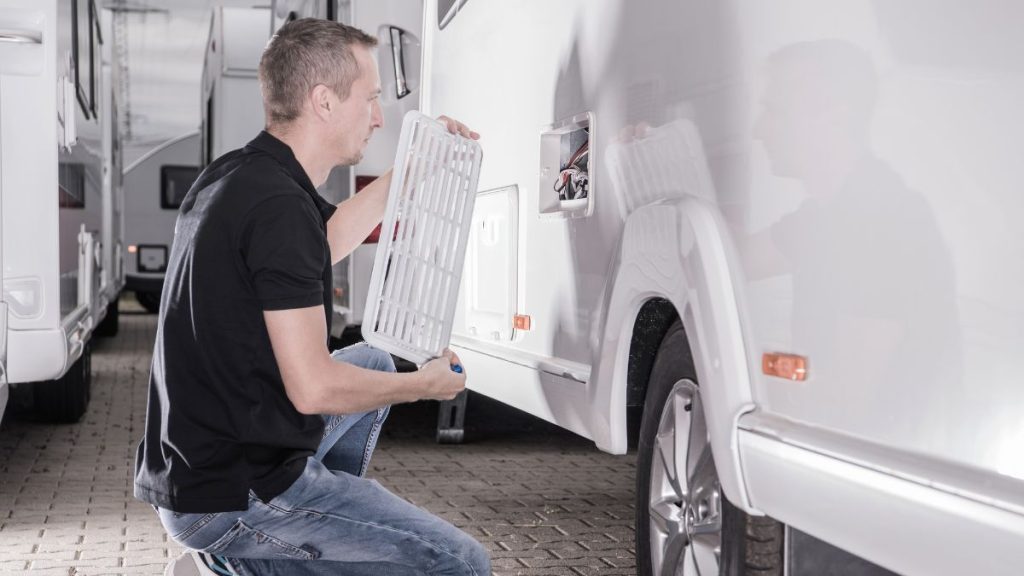Ants Invading Your RV? Get Rid of Them Quickly and Easily

Discovering ants in your RV can quickly dampen the spirit of adventure, turning your cozy retreat into a source of frustration.
These unwelcome guests are drawn to the abundance of food and shelter your RV inadvertently offers.
Fear not, as there are effective strategies to both prevent an ant infestation and address one that has already taken hold.
Clearing your RV of ants requires a combination of proactive prevention and targeted elimination techniques.
From natural deterrents to more robust solutions, this article aims to arm you with practical know-how to reclaim the peace and comfort of your RV.
Where and How Ants Enter RVs
Cracks and Crevices: Windows, Doors, and Slide Outs
Ants are tiny critters that can slip through the smallest of spaces. Check around the windows, doors, and slide-out sections of your RV.
These are common entry points that ants use to invade. Regularly inspect these areas for any small openings and use sealant to close them.
Underneath Access: Plumbing and Electrical Entries
Beneath your RV, there are several ways ants can find their way in. Pay attention to where plumbing and electrical lines enter your vehicle.
These conduits can have gaps ants might exploit. Ensuring these points are tightly sealed can help prevent an ant incursion.
Leveling Jacks and Chassis Gaps
Your jacks and underneath the chassis offer hidden passageways for ants into your mobile abode.
Look closely at your RV’s leveling jacks and utility hookups; these areas might have unsealed gaps.
Seal any potential openings you find to keep the ants from setting up camp.
Wheels and External Connections
Tires and any cords or water lines connected to your RV can inadvertently become bridges for ants.
Check these areas regularly, keeping an eye out for ant trails that may indicate an established path into your RV.
Implementing barriers or deterrents here can be effective to stop their march inside.
Signs of an Ant Infestation

Spotting Live Ants
If you’re noticing a parade of ants marching along your RV’s surfaces, that’s a clear sign they’ve set up camp.
These critters tend to follow established routes to and from their colony, often along walls or countertops.
Gathering of Winged Ants
Sometimes, your RV might host winged ants, known as swarmers, which emerge from the colony to start new ones. This can indicate a nearby nest.
Unusual Sawdust Trails
Piles of what looks like sawdust could mean carpenter ants are burrowing into your RV’s wooden structures, an immediate red flag for potential damage.
Dead Ant Sightings
Coming across dead ants can point to a nest inside your RV, as they often die close to their home base. Keep an eye out for such telltale accumulations.
Detecting Musty Smells
A musty odor can signal a large colony’s presence, as ants release pheromones that can be quite pungent when they’re gathered in large numbers.
Preventing Ants in RVs
Seal Entrances
Inspect your RV thoroughly for any cracks or small openings, especially around windows and doors.
It’s essential to seal these areas with caulk to prevent ants from entering your mobile space.
Cleanliness is Key
Maintain a strict cleaning regimen. Wipe away crumbs and spills promptly, dispose of garbage regularly, and store food in airtight containers.
This helps in eliminating any scent trails that may attract ants.
Natural Repellents
Consider natural options like peppermint oil or vinegar to deter ants. These can be used at potential entry points or around the perimeter of your RV:
- Peppermint Oil: Dab cotton balls with peppermint oil and place them around your RV.
- Vinegar Solution: Mix equal parts of water and white vinegar and use it to clean surfaces.
Create Barriers
Creating a barrier with natural substances can act as a deterrent:
- Cinnamon: Sprinkle ground cinnamon at entry points.
- Chalk or Coffee Grounds: Draw a line with chalk or lay out coffee grounds where ants may enter.
Ant Baits and Traps
Use ant baits and traps as a preventive measure. Place them strategically where ants are likely to enter but keep them out of reach of children and pets.
Environmental Considerations
When parked, treat the area around your RV with an ant repellent spray, focusing on the wheels and axles to create a barrier.
Remember to use eco-friendly options to protect the surrounding environment.
Getting Rid of Existing Ants in RVs

Identify and Treat Ant Nests
First, inspect your RV for ant nests under the chassis or within the walls—these are priority areas.
Once located, you can apply dusts or spray ant killers focally to diminish the nests. If you find this step challenging, consider consulting a professional.
Clean and Vacuum Interior Spaces
Ensure your RV is spick and span. Vacuum up any ants, sweep up crumbs, and clean surfaces diligently, as this will discourage ants from considering your RV a snack haven.
Utilize Ant Baits and Traps
Place ant baits that contain borax in strategic spots around your RV.
These baits attract ants, which then carry the poison back to their colony, effectively eliminating many ants over time.
Block Entry Points
Examine and secure common entry points by applying petroleum jelly or similar barriers.
This physical deterrent can be surprisingly effective in preventing ants from marching in.
Apply Natural Products
For a more natural approach, use diatomaceous earth or a mixture of vinegar and water to create barriers and clean surfaces.
Sprinkling baking soda mixed with powdered sugar can act as a homemade bait.
Consider Chemical Interventions
In extreme cases, you might opt for foggers or bombs with insecticides to reach every crevice.
However, use these methods as a last resort due to their harsh nature and ensure your RV is well-ventilated afterwards.